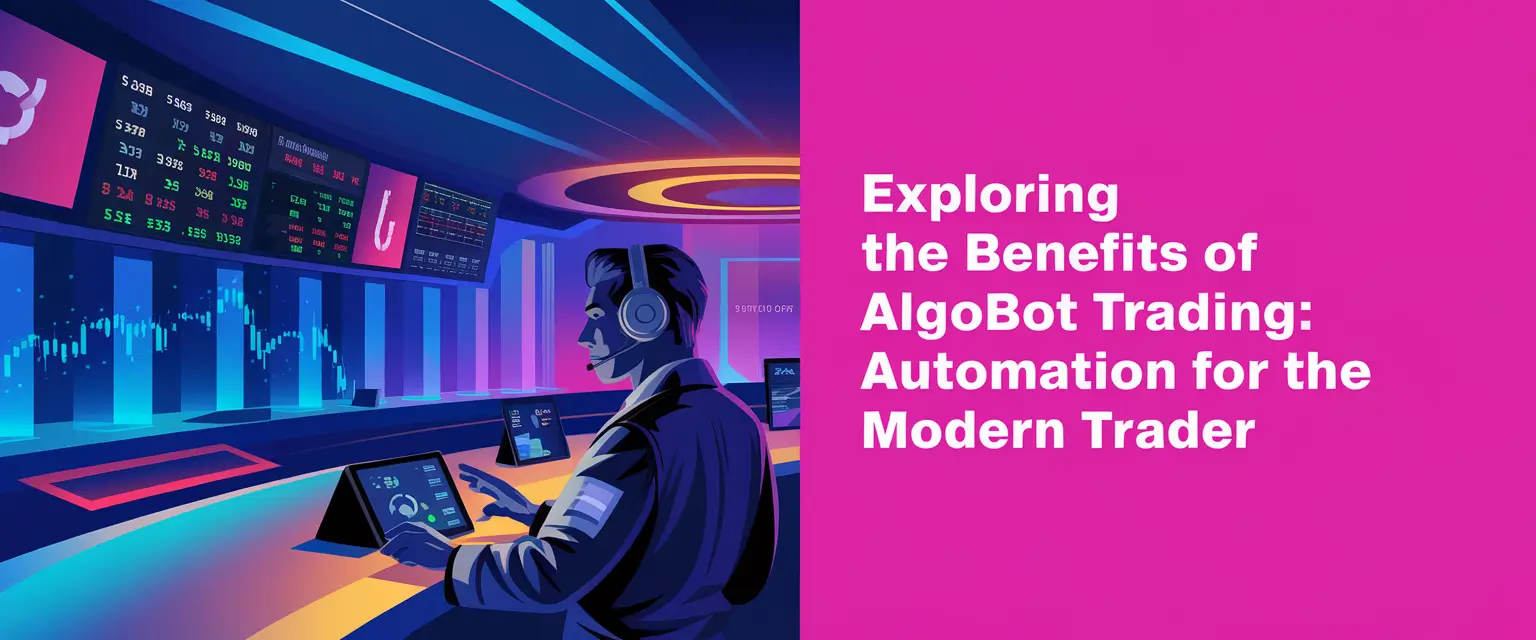Chainlink provides offline data to blockchain ecosystems via smart contracts. Many experts believe Chainlink will sit at the heart of the Web 3.0 era. But Chainlink is also popular with speculative traders, considering its wild pricing swings and high liquidity. However, to enhance your profits, it’s important to understand the associated trading costs. This guide explores the various fees associated with Chainlink trading. We also share tips to help you reduce these costs and enhance profitability.
Here’s a summary of how Chainlink trading works:Minimizing Chainlink Trading Fees: Key Takeaway
What is Chainlink?
Chainlink is a decentralized network that helps smart contracts access real-world information. Essentially, it helps blockchains communicate with external data sets, programming interfaces, and payment systems.
Thereby, Chainlink makes decentralized applications (dApps) more powerful and versatile. The digital token used within the Chainlink network is called LINK.
These digital tokens are used to:
- Remunerate for services
- Reward node operators (the individuals running the network)
- Secure the Chainlink network
Given its innovative use case, Chainlink has garnered a substantial following in the crypto landscape. It’s also widely traded across leading exchanges.
What is Chainlink Trading?
Chainlink trading involves buying and selling LINK tokens on crypto exchanges. As with other cryptos, Chainlink experiences high volatility. Traders speculate on LINK’s price movements, aiming to profit from market swings.
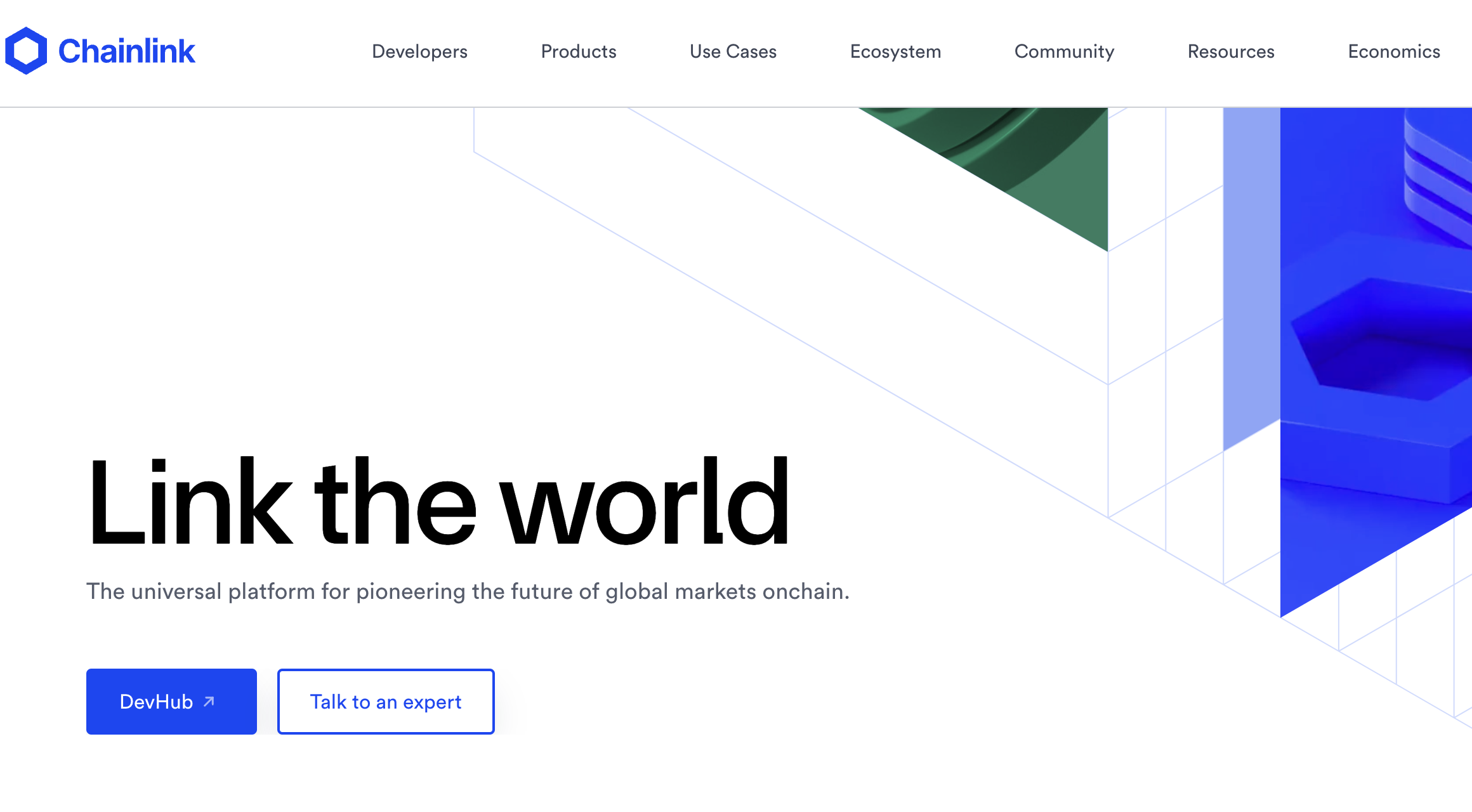
For instance, suppose a trader believes LINK will increase in value.
- They buy 100 LINK at $10 each, risking $1,000 in total.
- Later, the price rises to $11.
- The position is now valued at $1,100, meaning a $100 profit
However, the take-home profit from this trade will be less than $100. This is due to various trading fees that reduce the overall gain. As such, you should know how the Chainlink trading fees influence your profitability.
Types of Chainlink Trading Fees
Below are the primary fees associated with Chainlink trading:
Transaction Fees
Transaction(gas) fees are incurred when conducting a blockchain transaction. When you buy or sell Chainlink, a small fee is paid to the network to validate and record the transaction. These fees are essential for rewarding miners or validators.
Since Chainlink operates on the Ethereum blockchain, the network fee is paid using ETH. The gas fees change based on network congestion. They’re influenced by network demand. Naturally, a busy network leads to higher gas fees. And the gas fees may decrease during less busy times.
Commissions
Trading platforms impose commissions to facilitate transactions. These fees vary considerably depending on the exchange. Commissions are charged in one of two ways; percentage-based fees and flat fees.
Percentage-Based Fees
Most exchanges charge trading fees as a percentage of the transaction amount.
For example:
- Suppose you buy $1,000 worth of LINK, and the exchange charges a 0.2% fee.
- This means you would pay $2 in fees.
- Crucially, you must pay commissions at both ends of the trade – i.e., for buying and selling.
- So, if you sell the same LINK tokens for $1,200 – your commission will be $2.4.
- In this example, the total commission would be $2 + $2.4 = $4.4.
Many exchanges offer discounts when meeting minimum trading volumes. This structure incentivizes higher-volume trading since the absolute cost decreases as the trade size increases.
Flat Fees
Some exchanges may impose a flat fee regardless of the transaction amount. For instance, an exchange might charge a fixed fee of $1 per trade.
This fee structure can benefit large-scale trades, as the real commission percentage reduces as order sizes increase. Conversely, flat fees are detrimental to those placing small orders.
Maker-Taker Fee Structure
Exchanges sometimes charge different commissions for market makers and takers.
Maker Fees
These are charged to traders who provide liquidity to the market. This is achieved when placing limit orders.
For example:
- Suppose the current market price of Chainlink is $12.
- Instead of buying immediately at $12 (which would make you a taker), you place a limit order to purchase 100 LINK tokens at $10.
This order goes to the exchange’s order book until someone else is willing to sell LINK at $10. Since market makers provide liquidity, they are often rewarded with lower fees.
Taker Fees
These apply to traders who place market orders immediately against existing orders on the order book. For instance, you incur taker fees if you buy Chainlink at the current market price.
Market takers typically remove liquidity from the exchange. As such, they are charged slightly higher fees than makers.
Spreads
Every exchange has different quotes for Chainlink. The ‘bid price’ refers to the maximum amount a buyer is prepared to pay for Chainlink. In contrast, the ‘ask price’ is the minimum price a seller is willing to accept. The difference between these two price points is called the spread.

You can find the bid and ask prices by checking the exchange order book. Spreads vary depending on market conditions, the exchange, and the available liquidity. A wide spread increases your trade cost.
For instance:
- Suppose the bid price for Chainlink on your chosen exchange is $10.10.
- And the ask price is $10.05.
- Spread = bid – ask = $0.05.
- If you buy 100 LINK tokens, you’re indirectly paying a $5 spread
- The value of your position must increase by at least by $5 for you to break even on this trade.
Spread adds up with frequent trading. There’s no way to avoid this cost. Therefore, it’s important to choose an exchange offering competitive spreads.
Deposit and Withdrawal Fees
You might also encounter deposit and withdrawal fees when moving money into and out of exchanges.
- Deposit Fees – Most exchanges charge fees when depositing fiat into the trading account. For instance, you might have to pay a 1% fee for bank transfers and credit/debit card deposits. However, many platforms offer free deposits for cryptocurrencies.
- Withdrawal Fees – These charges apply when moving Chainlink from an exchange to your private wallet. Withdrawal fees vary widely and are typically charged in the crypto being withdrawn.
Ultimately, specific payment fees will depend on the exchange and the transfer method.
Chainlink Trading Example With All Trading Fees
Let’s explore how Chainlink trading fees work when accounting for the above costs:
- Your chosen exchange quotes bid and ask prices for Chainlink at $11 and $10, respectively.
- In this case, the spread = bid – ask = $1.
- You buy 100 LINK tokens at the $11 bid price.
- This brings the total purchase cost to 100 x $11 = $1,100.
Next, you need to consider the trading fee for buying.
- Let’s say your broker charges a 1% commission for both makers and takers.
- The commission for buying Chainlink is = $1,000 x 1% = $10.
- Additionally, you should also consider the gas fees – let’s assume it’s $1 for the buy transaction.
- This brings the total purchase cost to $11.
Now, your total cost after buying becomes:
- Total Cost After Buying = Total Purchase Cost + Trading Fee = $1,100 + $11 = $1,111.
Suppose the Chainlink ask price has increased to $15.
- Thus, the trade value is now worth 100 x $15 = $1,500.
However, you must also account for the commission and gas fees on the selling side.
Using the same 1% commission rate:
- Selling Fee = $1,500 x 1% = $15.
- Adding the gas fee for the sell transaction, the selling fee = $15 + $1 = $16.
Therefore, your net revenue after accounting for the selling fee is:
- Net Revenue = Total Revenue – Selling Fee, which is $1,500 – $16 = $1,484.
Now, let’s calculate your profit or loss:
- Profit/Loss = Net Revenue – Total Cost After Buying, or $1,484 – $1,111 = $373.
Hidden Costs to Consider For a Chainlink Trade
Most exchanges are upfront about their Chainlink trading fees. Nevertheless, there can be less obvious costs – such as:
Slippage
Slippage refers to the difference between the expected and the execution price of a trade.
For instance:
- You place a market order to buy Chainlink at $10.
- But, when the order is executed, the price has risen to $10.10. Here, the slippage is $0.10.
- Similarly, if the price drops to $9.90 instead, you would experience a negative slippage of $0.10.
This difference can be due to the rapid price movement in the market. Slippage is particularly prevalent when using market orders – executed at the next best available price.
You can mitigate this by employing limit orders. This way, you specify the exact price at which you’re willing to trade. This prevents trades from being executed at less favorable prices, avoiding slippage completely. After all, the limit order will remain pending unless the required price and amount is triggered.
Liquidity Issues
Liquidity refers to how easily you can buy and sell Chainlink without the trade significantly influencing its price. Chainlink’s liquidity varies across different exchanges, affecting the cost of trading. In fact, on low-liquidity exchanges, even a moderate-sized trade can substantially impact the market price.

This means you may end up paying a higher price when trading Chainlink. This becomes an indirect cost similar to slippage. Additionally, low liquidity leads to a wider bid-ask spread. Once again, this means you’ll pay more when buying Chainlink. You’ll also receive fewer LINK tokens when selling.
The only way around this is to trade on exchanges with high Chainlink liquidity. Larger, well-established platforms like Bybit have much deeper liquidity pools. This ensures tighter spreads and reduces hidden costs.
Conversion Fees
Conversion fees apply when you exchange one currency for another. For example, you might not have a digital asset that can be directly traded for Chainlink. So, you may first need to convert it to BTC or a stablecoin like USDT.
This extra step will incur conversion fees. To minimize this cost, use exchanges that allow direct trading between your assets and LINK. Also, consider platforms with competitive exchange rates to reduce conversion expenses.
Inactivity Fees
Some exchanges charge inactivity fees if your account stays dormant for a lengthy period. While these expenses are not directly trading-related, they can add up and carve into your long-term profits.
Ensure that you review the exchange’s policy to understand how often you need to trade to avoid fees. And if you don’t plan on trading frequently, consider transferring assets out of the exchange.
Factors Influencing Chainlink Trade Costs
There are several facets influencing the trading costs. Take a look below to learn more about Chainlink trading fees.
Platform Type
Crypto exchanges are classified into two categories: centralized and decentralized.
Centralized Exchanges
Centralized exchanges generally have a streamlined process and lower costs than their decentralized counterparts. This is because they carry out off-chain transactions – via private databases or layer-2 solutions. Meaning, you can bypass gas fees.
However, centralized exchanges are often custodial – meaning they store users’ assets in their built-in wallets. Binance, Coinbase, and Bybit are some of the most popular centralized exchanges.
Decentralized Exchanges
These are more secure due to their non-custodial nature. But, they process transactions on-chain. As such, you’ll be charged gas fees and any additional costs related to blockchain transactions. Examples include Uniswap and Sushiswap.
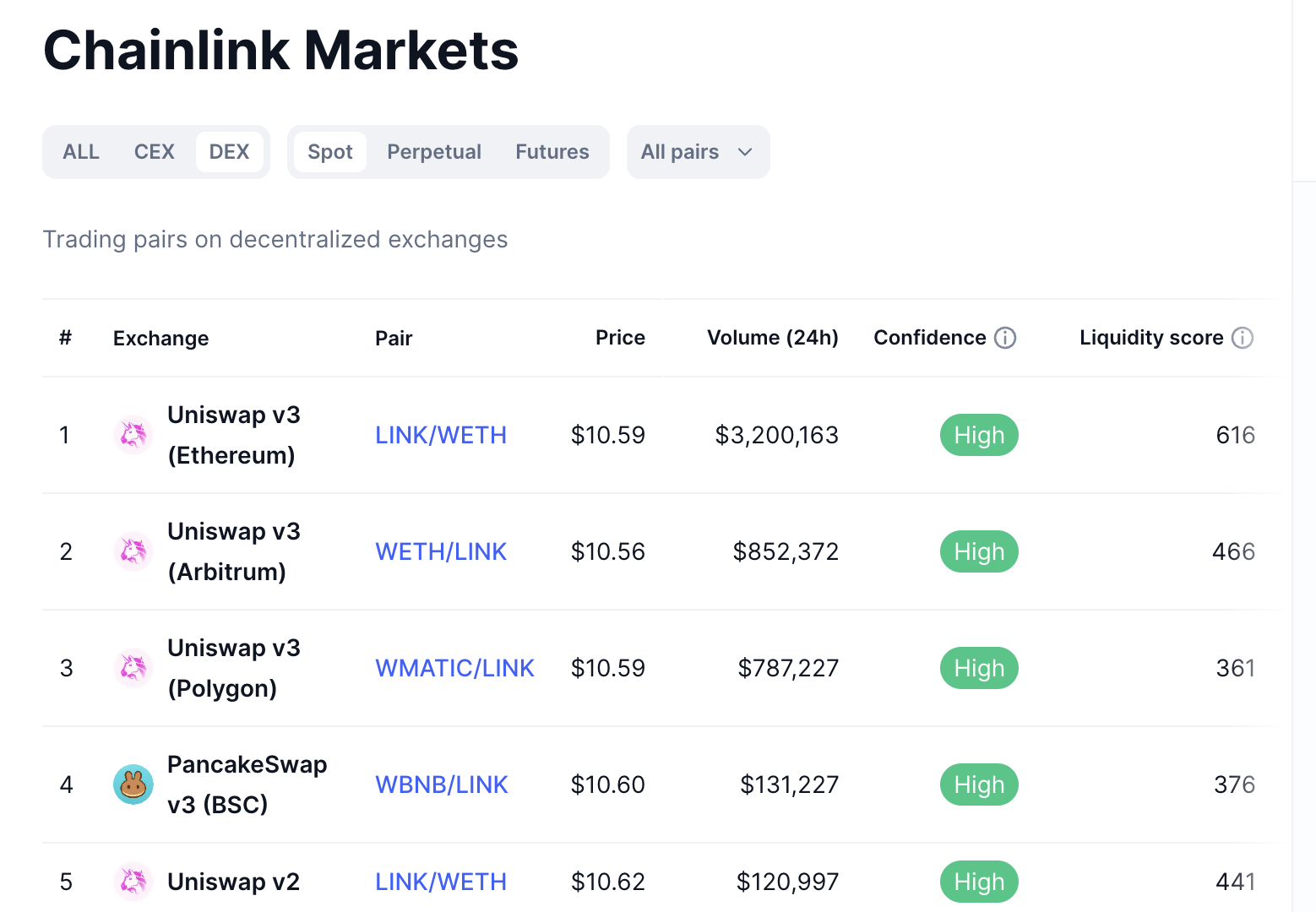
The choice between centralized and decentralized exchanges comes down to the trader. They not only differ in terms of fees and security but also in terms of user-friendliness. For instance, centralized exchanges provide user-friendly interfaces and customer support. This can make Chainlink trading more accessible and efficient for users.
Type of Chainlink Market
You can trade Chainlink on the spot or derivatives market. Fees vary accordingly, as exchanges have different commission structures for each asset type.
- Spot trading – This involves immediate settlement and generally has lower trading fees compared to derivatives.
- Derivatives trading – With derivatives, you’ll be trading Chainlink futures, options, or CFDs. These are instruments that track the price of LINK. With derivatives, you also have the option for margin trading.
Margin trading involves borrowing money from your exchange to amplify the investment size. For instance, if you’ve got $100 in your account, 10x leverage will increase the position size to $1,000. This can boost any potential profits.
However, leverage adds interest charges and borrowing fees that increase the overall cost of trading. It also increases the risks, as leveraged Chainlink positions can be liquidated.
Exchange Membership Levels
It’s now common for trading platforms to offer a tiered fee structure. Some exchanges use trading volume to categorize their users. In simple terms, higher trading volumes are rewarded with discounted commissions.
Additionally, many exchanges provide fee discounts when users hold their native tokens. For example, holding BNB on Binance can reduce trading fees significantly.
Time of Trading and Network Congestion
Liquidity deviates greatly during different hours of the day. High liquidity is generally available during peak trading hours, making it more efficient to place large trades. Peak crypto trading hours typically align with the overlap of major financial centers.
- For instance, the most active trading occurs between 8 AM and 12 PM Eastern Time (ET), when US and European markets are open.
- This corresponds to the evening for Asian countries like Japan and South Korea, promoting global participation.
- Despite the crypto market being open 24/7, time zones affect peak activity.
However, the issue is that high traffic on blockchain networks can cause execution delays. This can increase transaction costs like gas fees when using decentralized platforms.
Best Crypto Exchanges to Trade Chainlink
We researched the popular crypto exchanges, focusing on their fees and efficiency. Below are the top exchanges to consider when trading Chainlink.
1. ByBit – Market Makers Receive a 0.005% Rebate on Trading Commissions
ByBit is a popular trading platform for Chainlink. It supports spot and derivative trading, ensuring complete flexibility. Bybit’s spot trading fee is 0.10% per slide, which is competitive and on par with other major platforms. Fees are favorable for the derivative market also – with makers charged up to 0.02%. Takers pay a slightly higher commission of up to 0.055%.
ByBit offers market makers a rebate of up to 0.005% for both spot and futures markets. Moreover, spot and derivatives commissions can be reduced by increasing the trading volumes. Deposits of LINK are free, which is a major plus for users looking to maximize cost efficiency.

Withdrawals to an external wallet will incur gas fees – which vary depending on network congestion. ByBit also supports high leverage of up to 200x when trading Chainlink. It also features some of the best crypto futures trading bots – for grid, arbitrage, and martingale strategies.
Pros:
Cons:
2. Binance – Trade Chainlink With No Deposit Fees
Binance is known for its competitive fees and institutional-grade liquidity. It also offers various trading options, including spot, margin, and futures. For Chainlink trading, Binance charges a fee of up to 0.10% per trade. This fee can be reduced by holding BNB or increasing trading volumes.
In the futures market, commissions can go as high as 0.02% for makers and 0.05% for takers. For LINK deposits, Binance does not charge any fees. However, withdrawal fees vary and can be up to around 0.56 LINK per transaction, subject to network conditions.
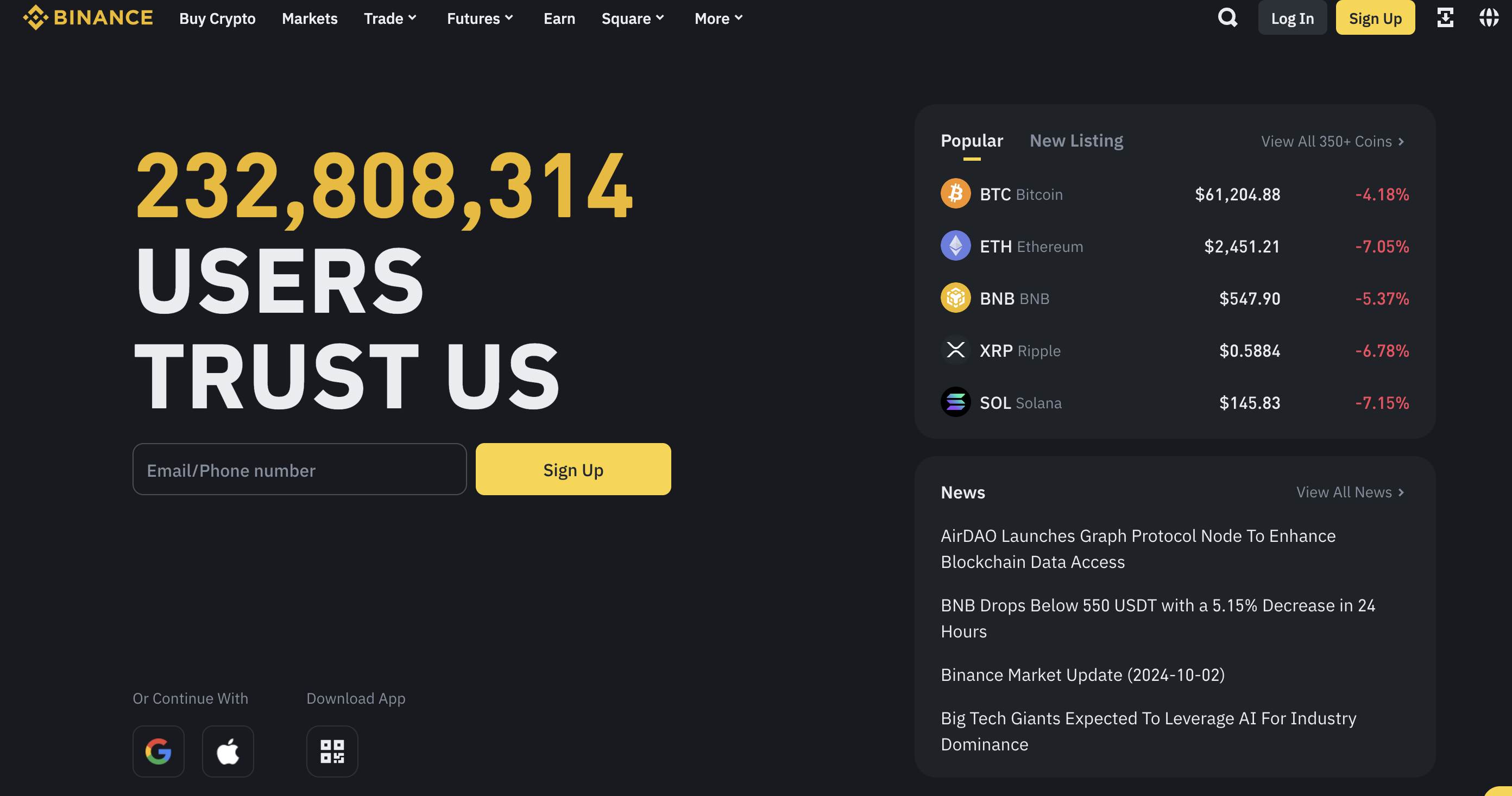
With its high liquidity, Binance ensures minimal slippage – even when placing large orders. It also offers advanced charting features, multiple order types, and support for hundreds of crypto pairs. Additionally, Binance offers algo trading bots to automate Chainlink trades.
Pros:
Cons:
3. Kraken – Trade Chainlink With Spreads as Tight as 1 Pip
Kraken allows users to trade LINK against various crypto and fiat currencies. It also offers deep liquidity with a spread as tight as one pip. Regarding commissions, the spot trading fees are up to 0.02% for makers and 0.05% for takers. Kraken charges the same fees for Chainlink futures trading.
Furthermore, reductions are offered for high-volume traders. When depositing Chainlink, you must transfer a minimum of 1.5 LINK. The deposit is processed fee-free. However, there are withdrawal fees involved, which comes to around 0.2 LINK.
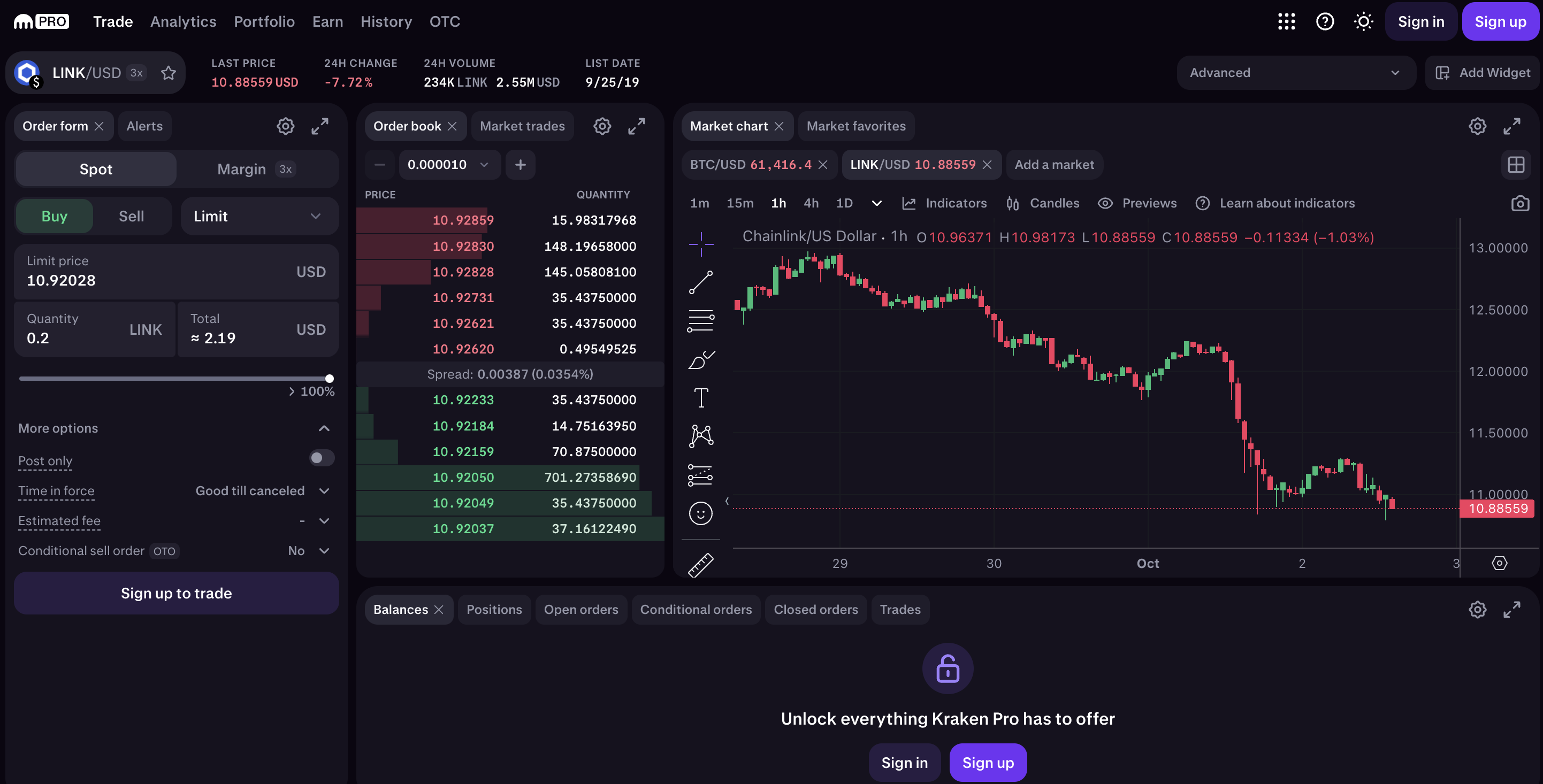
Kraken is also known for its advanced security features, including cold storage and strict regulatory compliance. Kraken also has a dedicated trading platform for professionals, with a wide array of analysis and charting tools. However, the leverage offered is limited to 50x.
Pros:
Cons:
4. KuCoin – Reduce Trading Commissions When Holding KCS
KuCoin also offers highly competitive fees for Chainlink trading. It charges a spot trading fee of up to 0.10% for makers and takers. For Chainlink futures, commissions are capped at 0.02% for makers and 0.06% for takers. As with other top exchanges, commissions can be reduced by holding the platform’s native token, KCS. This is also the case when reaching higher VIP tiers.
In fact, makers can get 0% commissions by capitalizing on these deductions. Chainlink deposits on KuCoin are free, while withdrawal fees vary depending on network conditions. KuCoin offers leverage of up to 125x. However, the leverage you can obtain depends on the KYC verification level.
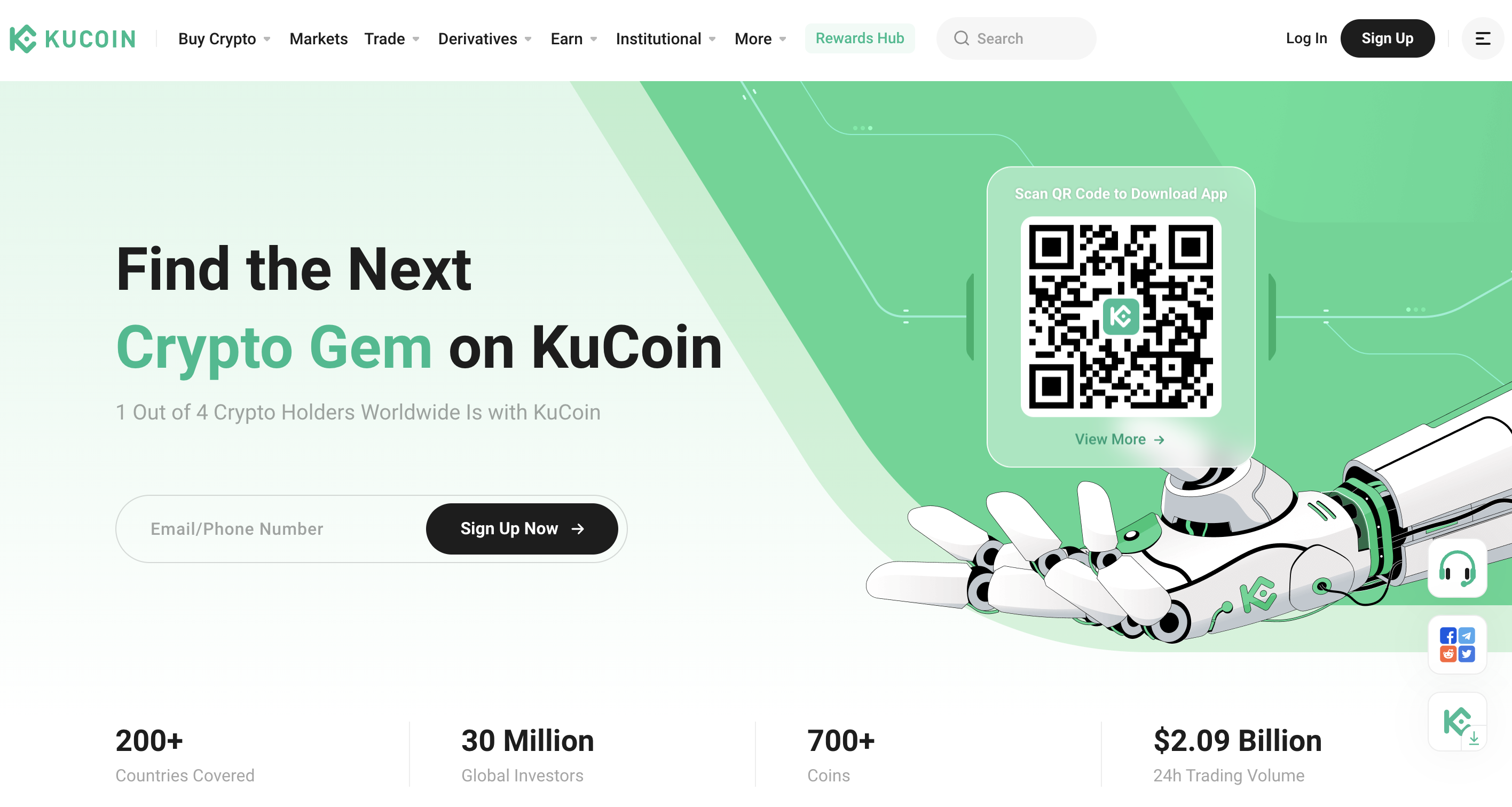
Though KuCoin offers advanced features, beginners may initially find the interface overwhelming. That said, trading bots are available to automate Chainlink trades. You can use them for spot and futures markets, covering the grid, martingale, and DCA strategies.
Pros:
Cons:
5. Uniswap – Choose Slippage Tolerance for Decentralized Trades
If you’re leaning towards decentralized exchanges, then Uniswap should be considered. This platform offers high liquidity and security for LINK trading. However, as we mentioned before, decentralized trading fees can be high.
Uniswap’s spot trading fee is set at 0.3% per transaction and is distributed to liquidity providers. Deposits and withdrawals are conducted directly through smart contracts. As such, users must pay Ethereum gas fees, which change significantly based on network congestion.
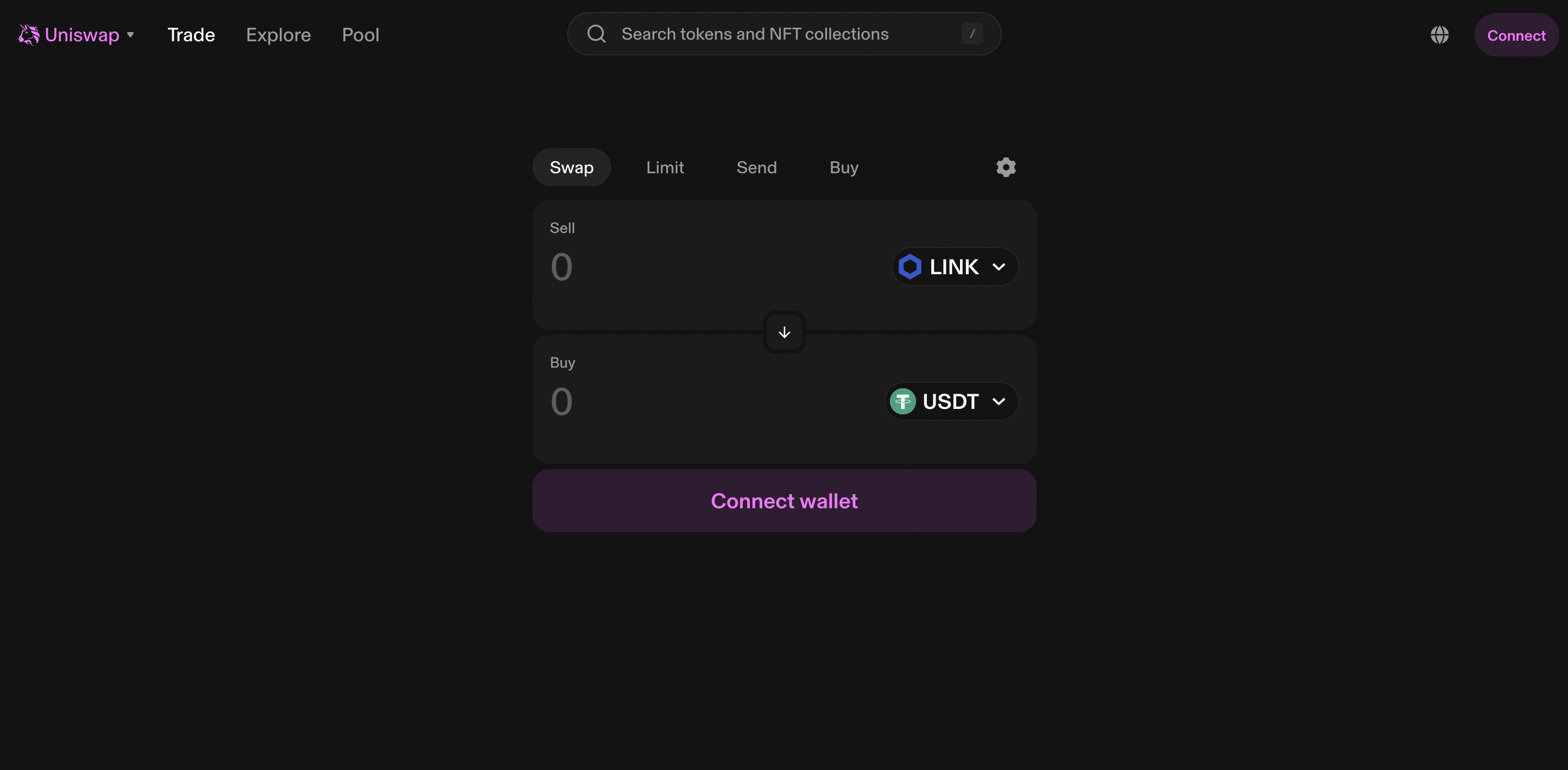
Therefore, the exact fees for Chainlink trading on Uniswap depend on the network traffic. But, it allows users to set parameters like slippage tolerance and transaction deadlines. This gives you some authority over the trade conditions and costs. Users also benefit from retaining full control over their assets. However, Uniswap doesn’t offer futures trading.
Pros:
Cons:
Leveraging Chainlink Trading Signals to Optimize Fees
Trading signals indicate when to buy or sell Chainlink, along with suggested prices. These signals are created by professional analysts or trading algorithms. You receive them as notifications. Each signal includes key details, such as the optimal entry price, target take-profit levels, and stop-loss thresholds.
Traders can then decide if they want to carry out the trade. Using Chainlink trading signals can, therefore, help optimize fees in the following ways:
- Minimized Overtrading – One of the main benefits of trading signals is the reduction of unnecessary trades. Many traders often buy and sell too frequently, raising transaction costs. By relying on expert-generated signals, traders can avoid impulsive decisions and focus on strategic trades. This minimizes transaction frequency and overall costs.
- Timely Execution – Trading signals are designed to alert users to optimal market conditions. For instance, they may generate signals when liquidity is high. This allows traders to execute orders with minimal slippage. This timely execution helps ensure that trades are carried out at the best possible prices.
- Reduced Emotional Trading – Manual trading can often lead to emotional decisions that impact profitability. By using crypto signals, traders have a data-driven approach. This leads to more disciplined trading practices, ultimately aiding in fee optimization.
In a nutshell, using signals for Chainlink trading can potentially help you save fees and optimize your transactions.
The effectiveness of Chainlink trading signals comes down to your chosen provider. Nonetheless, having access to reliable and timely trading signals can be a game-changer. Today, you can also find signal providers with 360-degree automation. This is where Algobot – the best trading bot stands out. Algobot’s offerings go beyond just signals. It integrates advanced algorithms and machine learning to generate trade ideas. Here are some of the top features of Algobot: Algobot not only works with Chainlink but all popular cryptos. You can also use it to trade stocks, forex, commodities, and indices. Crucially, you don’t need to worry about crafting or fine-tuning a strategy. Instead, you can sit back and allow Algobot to handle everything on your behalf
Best Chainlink Signals Provider With Automation
How to Minimize Costs When You Trade Chainlink
Here are some practical tips on how to reduce expenses when trading Chainlink.
Choose the Right Exchange
Your exchange choice plays a significant role in determining fees. Different exchanges have varying structures, including both trading and non-trading costs. Before you start trading, ensure you research and compare the fees of multiple exchanges.

Additionally, consider what features you obtain in exchange for the fees. Sometimes, extra subscription costs might be worth it if you get access to advanced trading tools or bots.
Utilize Limit Orders
Market orders execute trades at the current price. This often results in unfavorable prices due to slippage.
Instead, consider using limit orders – allowing you to execute positions at a predetermined price. While limit orders may take longer to execute, the cost savings could be significant.
Optimize Your Trading Frequency
Every trade incurs fees, including commissions, spreads, and possibly network costs. These charges add up rapidly, especially when deploying high-frequency strategies like scalping.
If reducing fees is a priority, consider focusing on fewer, well-timed trades instead. A strategy like swing trading aims for larger profits over a longer period. It also reduces the number of trades and limits fees.
Keep Your Account Active
As mentioned, the inactivity fee is also an aspect to consider. To avoid this charge, keep your account active by making occasional trades or participating in trading activities.
Additionally, staying engaged with the platform can provide updates on fee changes and promotional opportunities.
Common Mistakes to Avoid When Trading Chainlink
Neglecting fees is one of the main mistakes to avoid when you trade Chainlink.
However, you should also be aware of the following aspects to prevent losses.
- Failing to Manage Risk – Trading without proper risk management can result in considerable losses. Always set stop-loss orders and avoid investing more than you can afford to lose.
- Overtrading – Trading too frequently can accumulate transaction costs. Focus on quality trades over quantity to protect profitability.
- Ignoring Market News – Regardless of your strategy, you should keep up with crypto-related news. Any regulatory change or even social media sentiment might seriously impact Chainlink’s price.
Most importantly, it’s a significant error not to review your chosen exchange periodically. This way, you won’t miss any fee changes or updates that might affect your trades.
Conclusion
Understanding Chainlink trading fees is essential for protecting your bankroll. Trading fees come in many forms, such as commissions, spreads, and transaction costs.
Remember to choose the right exchange, manage your trading frequency, and stay informed about market conditions.
You can also take advantage of Chainlink trading signals to optimize your approach. With a little attention to detail, you can reduce costs and boost your potential returns when trading Chainlink.
FAQ
What are the different fees for Chainlink trading?
Chainlink trading involves various fees such as commissions, spreads, and funding costs. These costs differ depending on the exchange and transaction type.
How to minimize fees when trading Chainlink?
To minimize fees, choose exchanges with lower fee structures and take advantage of commission discounts. You can also avoid unnecessary trades by using well-timed, strategic entries and exits.
Do you pay fees when selling Chainlink?
Yes, you must pay trading fees when buying and selling Chainlink. The fees typically include commission, spread costs, and gas fees if trading on a decentralized platform.
How do you avoid crypto trading fees?
While avoiding fees entirely is challenging, you can reduce them by trading high volumes or holding exchange-native tokens. Alternatively, you can also look for promotional offers and trading during times of high liquidity.
Are there hidden fees in crypto?
Yes, hidden fees can occur as slippage, spreads, or extra costs associated with low liquidity and off-peak trading times. You should always check an exchange’s fee structure to understand all potential costs.




